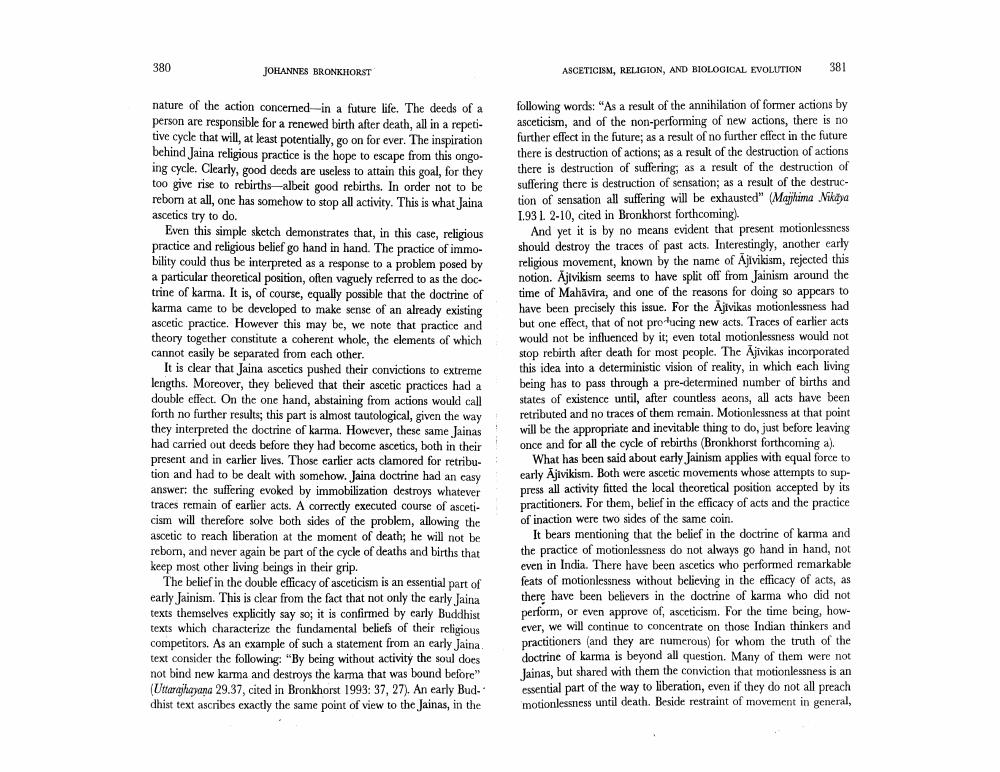Book Title: Asceticism Religion And Biological Evolution Author(s): Johannes Bronkhorst Publisher: Johannes Bronkhorst View full book textPage 4
________________ 380 JOHANNES BRONKHORST ASCETICISM, RELIGION, AND BIOLOGICAL EVOLUTION 381 nature of the action concemed in a future life. The deeds of a person are responsible for a renewed birth after death, all in a repetitive cycle that will, at least potentially, go on for ever. The inspiration behind Jaina religious practice is the hope to escape from this ongoing cycle. Clearly, good deeds are useless to attain this goal, for they too give rise to rebirths-albeit good rebirths. In order not to be rebom at all, one has somehow to stop all activity. This is what Jaina ascetics try to do. Even this simple sketch demonstrates that, in this case, religious practice and religious belief go hand in hand. The practice of immobility could thus be interpreted as a response to a problem posed by a particular theoretical position, often vaguely referred to as the doctrine of karma. It is, of course, equally possible that the doctrine of karma came to be developed to make sense of an already existing ascetic practice. However this may be, we note that practice and theory together constitute a coherent whole, the elements of which cannot easily be separated from each other. It is clear that Jaina ascetics pushed their convictions to extreme lengths. Moreover, they believed that their ascetic practices had a double effect. On the one hand, abstaining from actions would call forth no further results; this part is almost tautological, given the way they interpreted the doctrine of karma. However, these same Jainas had carried out deeds before they had become ascetics, both in their present and in carlier lives. Those earlier acts clamored for retribution and had to be dealt with somehow. Jaina doctrine had an easy answer the suffering evoked by immobilization destroys whatever traces remain of earlier acts. A correctly executed course of asceticism will therefore solve both sides of the problem, allowing the ascetic to reach liberation at the moment of death; he will not be rebom, and never again be part of the cycle of deaths and births that keep most other living beings in their grip. The belief in the double efficacy of asceticism is an essential part of early Jainism. This is clear from the fact that not only the early Jaina texts themselves explicitly say so; it is confirmed by carly Buddhist texts which characterize the fundamental beliefs of their religious competitors. As an example of such a statement from an early Jaina text consider the following: "By being without activity the soul does not bind new karma and destroys the karma that was bound before" (Uttarahayana 29.37, cited in Bronkhorst 1993: 37, 27). An early Buddhist text ascribes exactly the same point of view to the Jainas, in the following words: "As a result of the annihilation of former actions by asceticism, and of the non-performing of new actions, there is no further effect in the future, as a result of no further effect in the future there is destruction of actions, as a result of the destruction of actions there is destruction of suffering, as a result of the destruction of suffering there is destruction of sensation, as a result of the destruction of sensation all suffering will be exhausted" (Majhima Nikaya 1.93 L. 2-10, cited in Bronkhorst forthcoming). And yet it is by no means evident that present motionlessness should destroy the traces of past acts. Interestingly, another early religious movement, known by the name of Ajivikism, rejected this notion. Ajivikism seems to have split off from Jainism around the time of Mahāvira, and one of the reasons for doing so appears to have been precisely this issue. For the Ajivikas motionlessness had but one effect, that of not pre-lucing new acts. Traces of earlier acts would not be influenced by it; even total motionlessness would not stop rebirth after death for most people. The Ajivikas incorporated this idea into a deterministic vision of reality, in which each living being has to pass through a pre-determined number of births and states of existence until after countless acons, all acts have been retributed and no traces of them remain. Motionlessness at that point will be the appropriate and inevitable thing to do, just before leaving once and for all the cycle of rebirths (Bronkhorst forthcoming a). What has been said about early Jainism applies with equal force to early Ājivikism. Both were ascetic movements whose attempts to sup press all activity fitted the local theoretical position accepted by its practitioners. For them, belief in the efficacy of acts and the practice of inaction were two sides of the same coin. It bears mentioning that the belief in the doctrine of karma and the practice of motionlessness do not always go hand in hand, not even in India. There have been ascetics who performed remarkable seats of motionlessness without believing in the efficacy of acts, as there have been believers in the doctrine of karma who did not perform, or even approve of, asceticism. For the time being, however, we will continue to concentrate on those Indian thinkers and practitioners and they are numerous) for whom the truth of the doctrine of karma is beyond all question. Many of them were not Jainas, but shared with them the conviction that motionlessness is an essential part of the way to liberation, even if they do not all preach motionlessness until death. Beside restraint of movement in general,Page Navigation
1 2 3 4 5 6 7 8 9 10 11 12 13 14 15 16 17 18 19 20 21 22 23
